-----Granny Newton’s daughter Grace married Bob Lydic in November 1934 . They only had 1 child, William Lydic, born June 27, 1935 in Cody, Wyoming. William (Bill) Lydic married Audrey (Audie) Rhodes in Tempe, Arizona on October 7, 1956. Bill was 21 and Audie was 19 years old. Bill and Audie and their first 2 children Randy and Laciene, moved out to Susitna Station (Su Station for short) in 1960. Randy was almost 3 years old and Laciene was not quite 2 years old. Su Station was a remote location on the Susitna River, about 20 miles from any roads. The only way to get there was by boat in the summertime, or dog sled in the winter or by airplane. In the early 1900’s Su Station was a booming supply town for hardy pioneering goldminers and trappers travelling into the Interior of Alaska via the Susitna River, but by 1960 when the Lydics got there the original town had been abandoned and only a few cabins remained with just a handful of people living there at any one time. The people that were there lived very independent lives from one another connected only by difficult trails through the woods. For half of the year the ground was covered in deep snow and in those days people did not have snowmobiles like they do these days. They mostly walked to get around and walking in the snow could be a real challenge. Snowshoes were necessary most of the winter and the climate could be brutally cold. Dressing warm was a necessity. In the summer the temperature increased and the snow disappeared but the forest took over and you had to chop your way through the overgrowth. In addition to that you had to watch out for wildlife throughout the year. Running into bear and wolves and moose could be dangerous. However, the Lydics, as well as the other people at Su Station, were the adventurous types who were willing to brave the elements, the hardships and the wild animals in order to live a self-sufficient lifestyle in this remote area of Alaska.
------During the 1950’s and 60’s the Bureau of Land Management opened a homesteading program in Alaska which offered up parcels at Susitna Station. Bill Lydic’s grandmother, Eva Newton, endearingly known as Granny Newton, already had a small cabin on a 4.93 acre family plot that she began homesteading in 1956. (See my story about Granny Newton.) Granny had been living at Su Station for about 4 years by the time Bill and Audie and the kids moved there. The homestead lot the Lydics applied for was huge - a 160 acre -agricultural parcel. Homesteading was hard work and the bigger the parcel the more work it was. In the homesteading program, once you found the property you wanted to homestead you had to go out and stake it. Then you had to build a residence and live there a certain number of years in order to meet the requirements to get ownership of the property. You also had to clear and improve upon a certain percentage of the property. The larger agricultural lots like the Lydics applied for had more stringent requirements for improvement than the smaller family plots like Granny chose.
-----During their first summer at Su Station the Lydics lived in a 20 man tent (see photo attached) while Bill built their cabin on their lot up the trail about half of a mile from Granny. Paul Shanahan, who was homesteading a cabin across the river with his wife Edna, helped Bill to build the Lydic cabin in exchange for groceries and other supplies, basically a barter system, labor for goods. Paul and Edna became good friends with the Lydics and in the summertime they would ride across the river to visit in their boat that they called the Little Red Wagon because of its red color. In the wintertime they drove their dog team across on the frozen river to visit. It was also during this time that Paul got a pilot’s license and in 1957 he got his own airplane, a Piper J-3 Cub, for $1600 which he often flew to go visiting neighbors on the river. Over the following decades he worked in the airline business and became a very well known bush pilot. I read a really good article about him in the Anchorage Daily News by Joy Journeay titled “Alaska Aviation Legends, Paul Shanahan, Flying Frontiersman” published October 27, 2014. You can google it and read it for yourself. It’s a good article that gives him credit for his accomplishments.
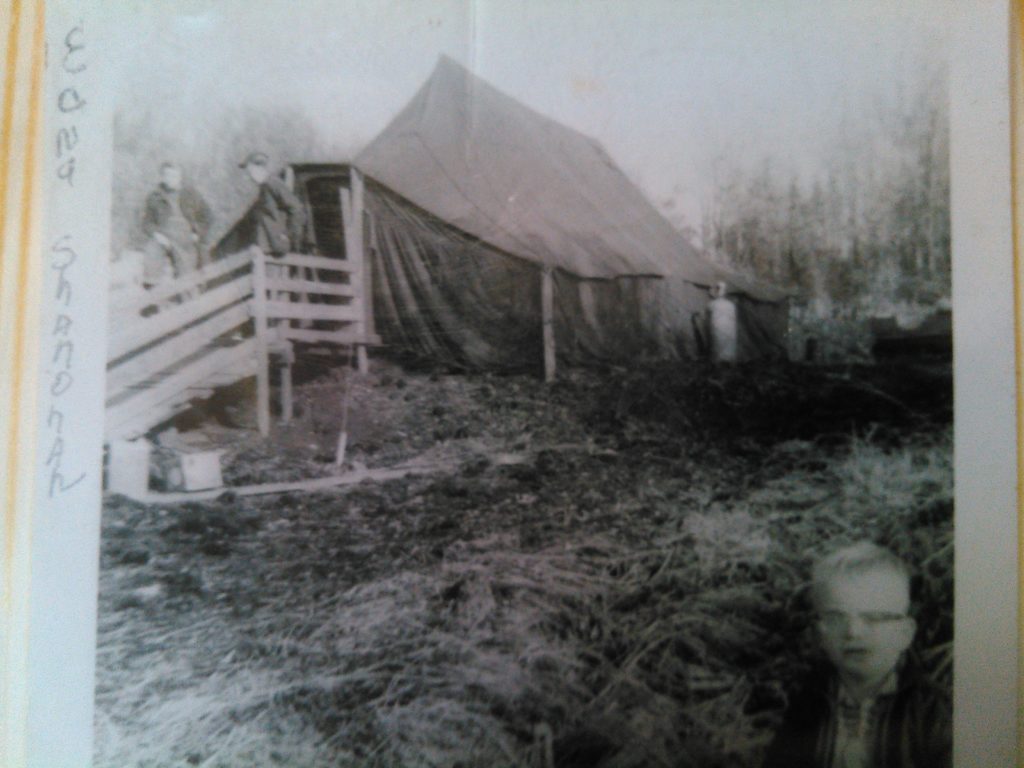
Living in a tent at Su Station 1960 from the Lydic Collection
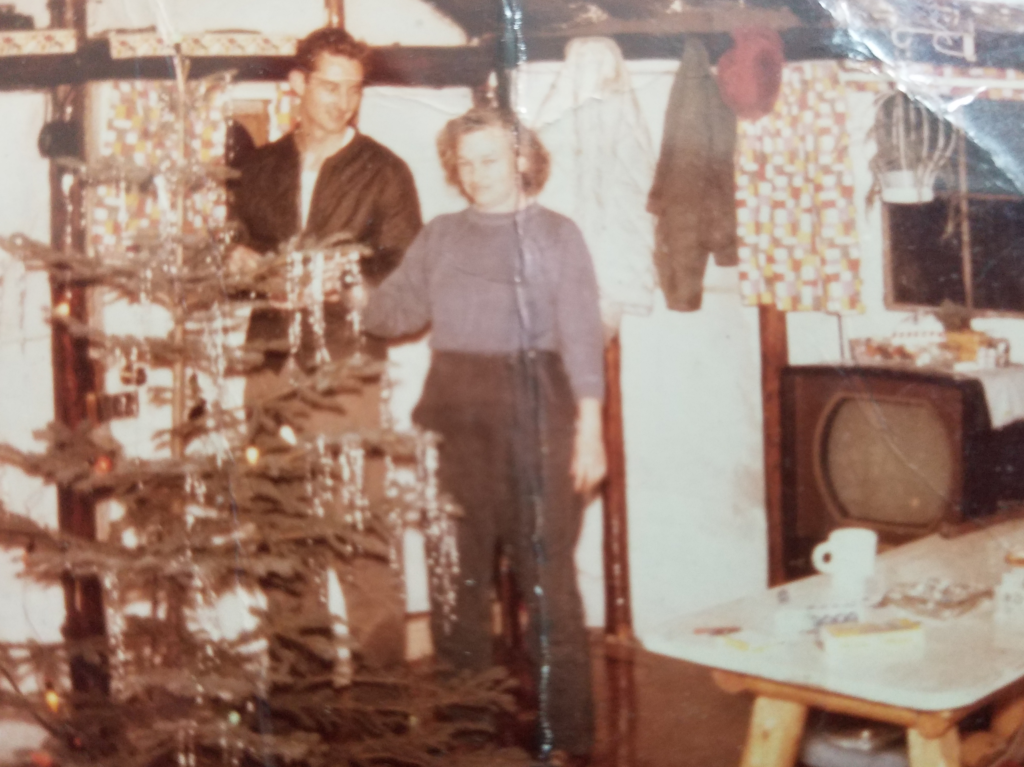
Paul & Edna Shanahan at their cabin on the Su-Lydic Collection
----- When Bill Lydic first arrived in Alaska he planned to work for his Uncle Charles at the family business Matanuska Plumbing and Heating. However, his mother Grace worked at the YMCA with Annie Chestnut and through her Bill met Annie’s husband Al Chestnut. Al worked for Alaska Concrete and Conduit and he got Bill a job there with him. Al and Annie Chestnut lived in a cabin at Flathorn Lake which sits in close proximity to Susitna Station - about 8 air miles away. This is also where Joe and Vi Redington lived, and this is how the Lydics started friendships with both the Chestnuts and the Redingtons. They were all living similar lives out in the backcountry away from the city life which gave them a unique connection. From Susitna Station you can fly or go overland through swamp to Flathorn or you can go by boat down the Susitna River. If you take a boat you have to go downstream on the Susitna River about 10 to 12 miles and then go up Fish Creek from the Susitna River about 6 more miles. We have friends that have a cabin at Flathorn now and they often take their jet skis down the river past us to their cabin.
-----The Lydics built their cabin at Susitna Station in the Summer and Autumn of 1960. Most of the building supplies for the cabin were brought in to the Lydics from Anchorage across the Cook Inlet on the Nomad, a boat owned and operated by Joe Redington. The Lydics finished their cabin and were able to move out of the tent and into their new cabin just as the first snow began to fall in October of 1960. It was a large cabin, the biggest at Susitna Station at the time. It was very nice but still very rustic. The Lydics heated their cabin with wood and there was no electricity for lights. They used propane lights and lanterns. They had an outhouse and during cold winter nights Audie took 1 pound coffee cans with lids on them and put them under the children’s beds to use so they didn’t have to go outside in the dark and cold. Every morning she would empty the cans. I can relate to this as I have a bucket at our cabin and especially on cold winter nights I use it instead of walking out to the outhouse in the dark and the cold. The Lydics dug a small well with a hand auger that got water at about 10 feet. In the summer they could use it but in the winter they took it out and put it up. Otherwise it would freeze up. In the winter Audie collected snow in a 5 gallon galvanized tub and heated it up for drinking, dishes, laundry etc.
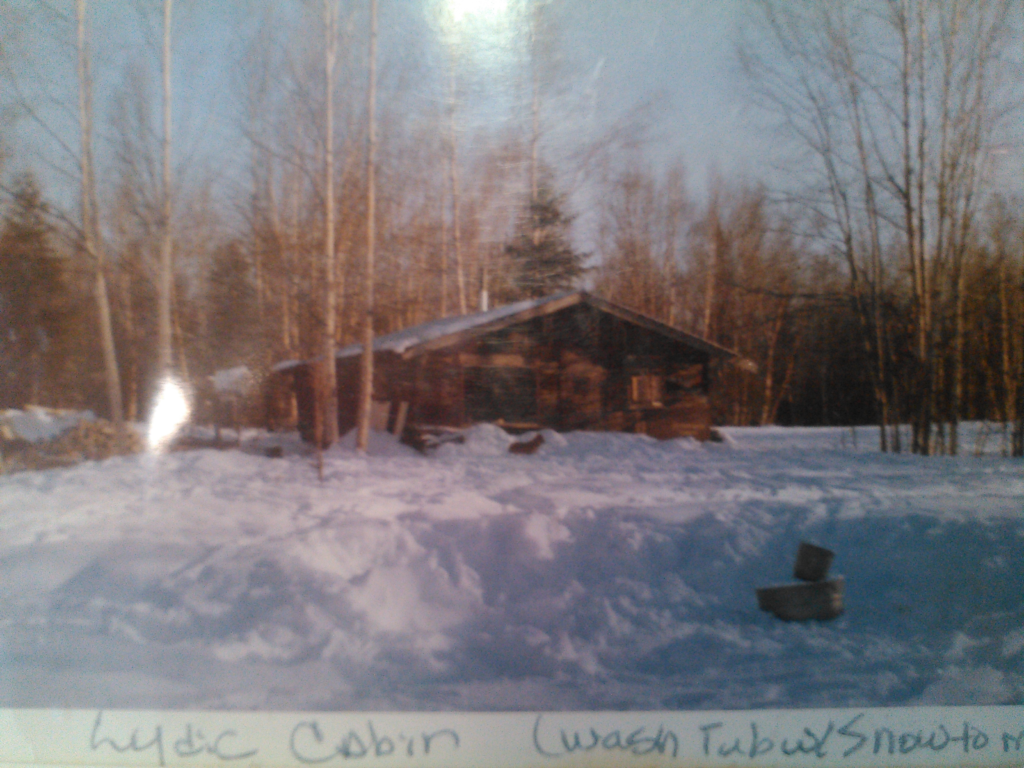
The Lydic cabin 1960 from the Lydic Collection
-----Bill worked 5 days a week in Anchorage at Alaska Concrete and Conduit. In order to do so he took a plane in and out of Susitna Station every week – staying in Anchorage for the work week and coming home to Susitna Station on the weekends. To me, this is a pretty interesting part of the story because that left Audie, in her early 20’s, at Susitna Station with two young children all by herself 5 days a week. And she was not an experienced outdoors woman. She will tell you she was a city kid and it is so impressive that she was able to handle living out there alone. Bills mother, Granny Newton was there in her own cabin but it was quite a walk from the Lydic cabin to Granny’s about a half mile away. There were also other Susitna Station residents that would visit occasionally. As with Granny, the Lydics became especially close with Nick Barbul, the last Dena’ina Indian who lived at Susitna Station. (See my story on Nick Barbul.) They also became close with a few other residents of Susitna and family and friends from town would also come to visit occasionally. But mostly Audie spent her time alone with the kids taking care of the day to day business on her own.
-----Unlike Granny, the Lydics did have radio for communication. Vi Redington and Audie grew close during this time and stayed in contact by two way shortwave radio daily. The Lydics had License #KXP-95 and Vi and Joe Redington’s shortwave was License #KXF-70 Flathorn. Just having a friend to connect with daily was comforting to Audie. Because they had no phones, no roads, etc. the shortwave radio was their lifeline to the outside world. The Lydics also checked in with Radio Anchorage twice a day as a kind of safety check. Radio Anchorage could also do a phone patch to a land line if needed as well as summon emergency help. The family would listen to Northwind and MUKLUK telegraph on the regular radio twice daily also – one program was on KENI 550 am and the other on KFQD 750. They used this system to receive important messages from the outside world.
-----The Lydics got their first dogs from the Redington’s. Bill Lydic had a Weasel (WWII vintage US Army track vehicle) that he walked across the swamp from Susitna Station to the Redington’s at Flathorn Lake so that Bill could help Joe build a dock. After the job was done and Bill pulled back up at Susitna Station in the Wiesel everyone was surprised to see that the cab was full of sled dogs that Joe Redington had given him. 12 adult dogs to be exact! The Lydics made these dogs into 2 dog teams. One of the dogs was named Kyanna and she was already trained as a lead dog. Having a good lead dog made all the difference when running a dog team. The dog that became the lead dog on the 2nd team was Lonesome. From that point on the Lydics had sled dogs at Susitna Station. They learned to run a dog team, cook for the dogs and Bill built the 2 sleds as well as all the harnesses for them himself. They also built 12 doghouses that they kept in the yard. They collected grass in the summer for the dog’s bedding. The dogs were kept chained to their houses most of the time or they would run off. They spent a lot of time sitting on top of their houses. The dogs became part of the Lydic family and they made getting around in the wilderness much easier and Audie said life with them was always interesting.
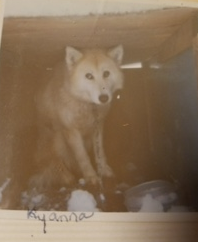
Kyanna from the Lydic Collection
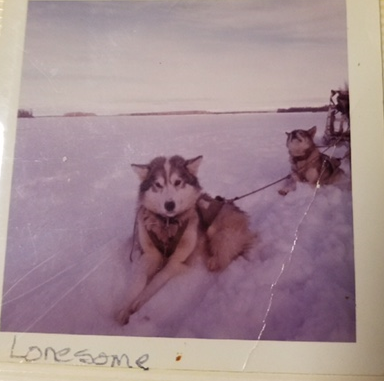
Lonesome from the Lydic Collection
-----During the time that the Lydics and the Redington’s were friends, Granddaddy Redington was still alive and the Lydics say he was a great storyteller. Joe Redington was also a great storyteller- a talent probably passed on to him from his father and from living such an adventurous life. Joe Redington became a very famous Alaskan. He is credited for starting the Iditarod Sled Dog Race. He is nicknamed “The Father of the Iditarod”. The first race from Anchorage to Nome was in 1974. For many years the Iditarod ran right through Susitna Station. Jeff, my sweetheart, has many stories of watching the Iditarod run past his cabin out there. The Iditarod is still a major event each year. It doesn’t run right through Susitna Station any longer but we always drive about 3 miles upriver to watch it go by. Joe Redington ran the race 17 times. He ran it into his 70’s. He was quite an adventurer. One year he even took a dog team up to the summit of Mt. McKinley with Susan Butcher and 3 other people. One of the people with him was a photographer named Robert Stapleton and he took a picture of Joe and his dog team on the summit of Mt. McKinley which you can find online. It’s a great photo!
-----Al Chestnut was a pilot and he flew a Supercub. It was really nice having a friend with a plane. It came in handy for emergencies a number of times. Al and Annie Chestnut also had 4 children. They had three girls and a boy. Cheryl Chestnut used to babysit Randy and Laciene. The other girls were Kathy and Debbie. Their son, Lonnie, grew up to be a pilot like his dad. The Chestnuts came up to Alaska when the kids were little and homesteaded their property at Flathorn Lake around the same time as the Redingtons. Joe Redington gave them a ride out there on his boat, the Nomad, when they first arrived. The Redington’s also had 6 children. 2 boys and a girl: Joee, Raymie and Sheila, that Joe had with his first wife Cathy, 2 boys: Tommy and Timmy that Vi had with Ray Redington, Joe's brother, who she was married to first, and then Keith, the son they had together, the youngest of the brood. Life in the bush was a real family affair. Randy and Audie have fond memories of time spent with both families.
----- Randy and Audi remember riding around a lot in Joe’s boat the Nomad. In addition to hiring Joe to take them to pick up supplies for their cabin in his boat many times, Joe Redington also used the Nomad to pick up fish from the Lydics and other fishermen who setnet for salmon on the Cook Inlet at a place called Fish Camp at the mouth of the Susitna River every summer. Setnetting provided people in the area, including Audie and Bill, with additional income in the summertime as well as food for them and their dogs. They would catch their fish and then Joe would come by in the Nomad and pick up the fish and deliver it across the Inlet to the Emard Cannery down at Ship Creek in Anchorage. Joe had a barge that he pulled behind the Nomad that was separated into boxes where each family put their fish. The Lydic’s along with other setnetters, including the Redington’s, would wait for Joe after the fishing period was over and he would show up in his boat to pick up the fish and either take it to the cannery or deliver their fish home if they wanted to keep it. Audie remembers Joee and Raymie Redington, two of the older boys, fishing down at Fish Camp in those days also. Forty or fifty fish at a time was a good haul and would feed them and the dogs for quite a while. Randy says they ate fish, then more fish and then fish to the point that he doesn’t like seafood any more. I can relate a bit. When I was growing up in Alaska my dad always caught salmon and we ate so much of it I got sick of it and stopped eating it. Then I left Alaska for about 8 years and when I returned I had salmon again and realized how much I missed it and how good it really is. I love it again now. It’s such a delicious, healthy fish that I feel truly blessed to harvest every year.
-----One time Audie got to drive the Nomad from Fish Creek to Anchorage for Joe. He told her he needed her to drive it to the cannery while he was counting fish in the barge behind the boat. She was a little worried. She told Joe she had no idea how to drive the boat or how to get it to Anchorage. He said “Well you see those colorful buildings over there?” (pointing to the old green L Street Apartments and the pink McCay Building which stood out in the Anchorage skyline across the Cook Inlet) “Well, head the boat straight toward them!” So she drove the Nomad across the Cook Inlet and says it was fun and it made her feel important! It’s not everyone that can say they drove a boat across the dangerous Cook Inlet and Audie can say she not only drove the infamous Cook Inlet but was the Captain of Joe Redington’s boat the Nomad for a day!
-----Besides radio communication the only other communication with the outside world while at Susitna Station was by US mail. Although there was a United States Post Office at Susitna Station until 1946, by the time the Lydics got there in the 60’s the Post Office was gone. Instead the Post Office contracted Spernak Air, a private company with a Supercub, a very popular small airplane, to deliver the mail once a week by air. George Spernak was the owner as well as the pilot. Spernak delivered mail to Susitna Station as well as other homesteaded areas on the river such as Alexander Creek and Skwentna. The mail was delivered in green mail sacks. In the summertime George Spernak would land on a sandbar on an island in the middle of the river near Susitna Station and the residents would take a boat over to meet him and pick up the mail. In the wintertime he would land on skis on the river. Once in a while Mr. Spernak would drop the mail to Audie from the plane directly to a clearing near their cabin. Mr Spernak would buzz the cabin to let her know he was there and then drop the bag out of the airplane to her. One time Randy remembers his mom climbing a tree to retrieve a bag that got stuck in it! Mr Spernak was well known to river folk and I’m told he was very well liked. Although he flew in all kinds of weather there were times that the saying WPPW took precedence– weather pemitting pilot willing! Unlike the Post Office which delivers come rain or shine there are times when it isn’t prudent in Alaska to take a plane out in bad weather. George Spernak’s son Mike took over after him and Spernak Air is still in business today doing small charter jobs in the area in addition to continuing to deliver the mail to remote towns in the Cook Inlet region such as Tyonek, Alexander Creek and Skwentna, although not to Susitna Station any longer. Spernak Air is located on Merrill Field in Anchorage. Their phone number is (907) 272-9475. Contact Mike if you want to charter a plane in Southcentral Alaska with a long time- experienced pilot.
-----Being such a rookie to cabin life Audie had to learn a lot of new skills like cutting firewood, building fires, cooking with a woodstove, trimming wicks, conserving kerosene, and how to take precautions to survive living among wild animals. She learned on the job! One time Bill drug a big tree home to chop up later for firewood. The moose figured out it was easier to eat the tree already on the ground and Audie threw soup cans at them to shoo them off the property! This story is funny to me because it’s true that if you chop down a tree the moose always seem to find it. It’s almost like they hear the chainsaws and think it’s the dinner bell!
-----The Lydics new cabin had a 4 x 8 picture window in it. One day Audie was looking out the window and saw a pack of dogs outside. Their neighbors, the Sorensens, down the trail about a half mile away had sled dogs and Audie thought that it was their dogs that had escaped which they tended to do. So Audie grabbed a leash and some dog food and ran outside trying to catch the dogs before they got away so that she could get them back to their owner. However, she had no luck catching them and they ran off. Come to find out the Sorensen’s dogs were snug at home and what Audie had been chasing was a pack of wolves!
-----It always seemed like things happened to Audie when Bill was away working and she had to learn to handle emergencies on her own. One time when they first got to Susitna Station and they were still living in the tent while their cabin was being built, Audie had one of her first scares. She was doing breakfast dishes inside the tent and Randy and Laciene were playing outside together. The tent was closer to Granny’s than the cabin being built was but it was still quite a walk down a trail through the woods. Randy, who was not quite 3 years old came inside and he told Audie that Laciene, who was not even 2 years old, had taken off down the trail for Granny’s. Audie in a panic ran outside and down the trail after her. She found Laciene a ways down the trail luckily but the really scary thing was that Granny came walking up the trail soon after and reported that there had been a bear spotted in the area. This would put a fright into any mother. Audie says she still has gray hairs over it.
-----Another time while Bill was gone Audie had the kids out in the woods with her while she was collecting firewood. The sled was being pulled by the dogs and the kids were sitting in the sled on top of the wood. It was winter and the kids had on their heavy coats and Audie after getting back to the cabin was unleashing the dogs when one of the dogs lunged at Laciene and bit into her on her back and on her stomach. The dog got a grip and wouldn’t let go and the only way Audie could get the dog to loosen its grip was to choke it out until the dog passed out. Then not being sure how bad the wound was or if the dog might have rabies etc. she called Vi Redington on the two way radio and Vi contacted Al Chestnut who had just gotten home from work. Al jumped in his Supercub and flew to Susitna Station landing on the swamp down the trail from their cabin. This is one of those times that it was invaluable to have a friend with a plane! Al gave them a ride to Anchorage where it was determined that Lacience would survive and didn’t need stitches. This little girl had her share of trouble!
-----Little Randy wasn’t without trouble either. One Christmas Randy got a child size carpenter tool kit from his grandpa Joe who was a Master Carpenter. It wasn’t a pretend tool set either. It had a real hammer, 2 real saws, a real square and a real plane. These weren’t plastic toys. They certainly wouldn’t be sold to children these days. Randy loved it. He and Laciene each had a crib in the children’s room. Randy could get in and out of his crib by climbing over the railing but Laciene was too little so she was stuck in there. Audie was always comforted that Laciene was in her crib and Randy would never leave the children’s room without Laciene. However, early one morning Randy was playing in the room while Laciene was in her crib and he got to thinking that he had his tool kit and he’d seen where it would cut wood so he took the saw and started cutting the railings on Laciene’s crib. He got a couple rails out and Laciene squeezed out through the opening he made. Pitter patter they both went out of their room to their mom and dad’s room so proud of themselves. Mom was not as pleased as they were! After the kids left Audie laughed. Randy was pretty ingenious for a 3 year old with his Grandpa’s carpentry skills!
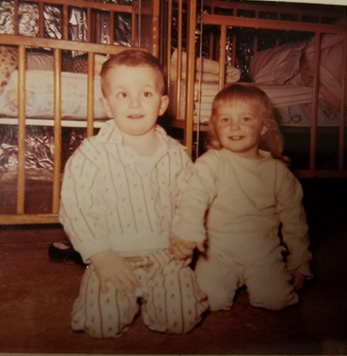
Randy & Laciene & the crib with the escape hatch Lydic Collection
-----Randy remembers walking the trail many times with his mother and Laciene. In the summer, about twice a week, if the chores were done, Audrey would pack the three of them a picnic lunch of peanut butter and jelly sandwiches and a packet of koolaid in an empty gallon apple cider jug with sugar in it on a back board and they would head down the trail toward the beach as they called it. What they considered a beach was a sandbar on the Susitna River that appeared every Spring after break-up and lasted into the Summer. There is still a sandbar there every year to this day (see my photo taken in recent years). When it was time for lunch they would walk to the spring and add water to their koolaide and sugar in the jug and have a drink and eat their PB & J sandwiches. Randy has a clear memory of his mom in a red plaid jacket walking up the trail with a 30.06 slung over her shoulder. This is bear, moose and wolf country and it’s best to be prepared with good defense if needed! I know I feel the same these days. I never walk the trail without a gun. I saw quite a few bears around this past summer.
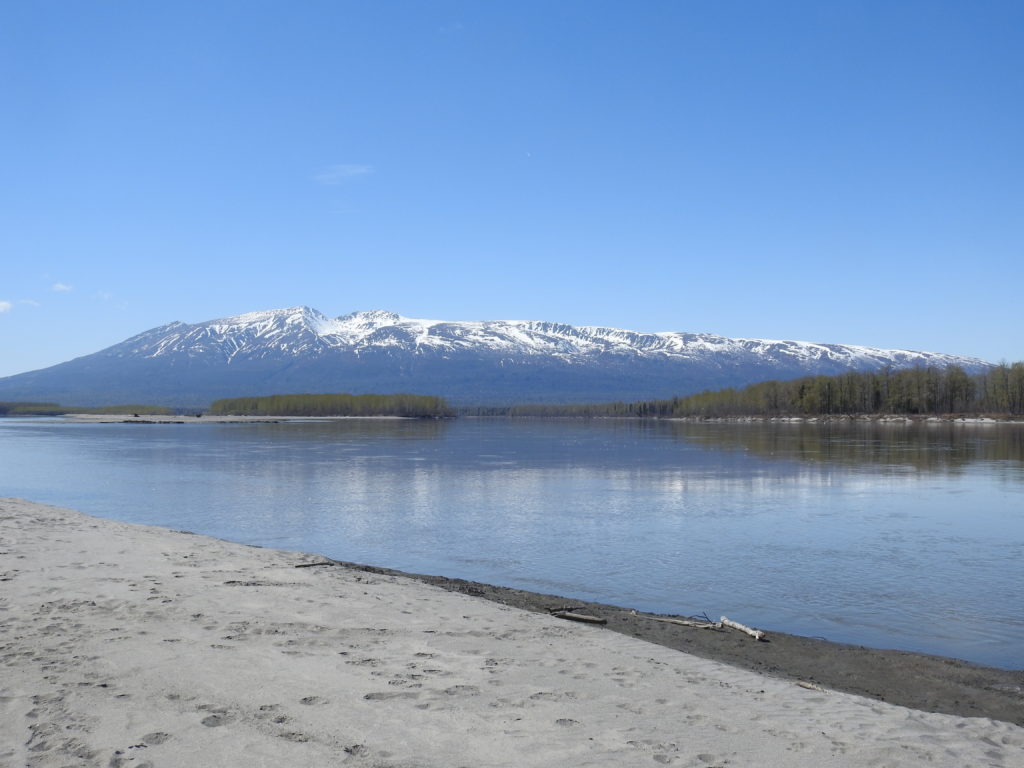
The beach at Susitna from my collection 2017
-----Audie and the kids also spent time berrypicking which they made into homemade jam or jelly. They found patches of blueberries and currants and they picked highbush cranberries. Their neighbors, the Sorensens, also had a large patch of raspberries which they invited the Lydics to pick. This is the same property that Jeff now owns and the raspberries are still there. The Lydics also planted their own raspberry plants that they got from Cliff Forsberg who also had a cabin at Susitna Station. Randy Lydic said that Cliff had the best raspberries around! The raspberries they transplanted are still growing on the old Lydic homestead. I noticed them among the overgrowth near their old cabin homesite this past summer.
-----The Lydics tried to grow a garden but didn’t have a lot of success. Their property was in the middle of the forest and I suppose there wasn’t enough sunlight or maybe the soil was just too acidic. Audie didn’t even have much success with potatoes. Luckily they had a friend, Dick Wells, who managed a Piggly Wiggly in Anchorage and when canned goods came in to the store without labels and they couldn’t be sold the Lydics were occasionally the recipients of these unlabled vegetables. Randy remembers what a surprise it was at dinnertime to see what was in the can and what they were having for dinner that night! Dick and his wife Pat had three kids: Wanda, Karen and Curt and every summer Pat and the kids would come out and visit for a couple weeks in the summertime and Randy and Laciene really enjoyed having the Wells children there to play with.
-----Audie’s dad, Floyd, who the kids called Grandpa Floyd and Audie’s mom, Grandma Lorene Rhodes, also came and stayed at Susitna Station a couple of times, once in 1961 and once in 1963. Audie’s mom couldn’t believe the rustic conditions her daughter lived in! They were from the city and unaccustomed to life in the wilderness. But Grandpa Floyd loved to fish down on the beach. He also loved to go hunting with Bill. Bill Lydic would hunt for moose every year. They had a root cellar under the kitchen floor where they would hang moose sides in the Fall and Winter. Randy remembers his mom making pancakes and moose steak for breakfast often. He also remembers his mom using a hand grinder on the kitchen counter to grind up hamburger meat out of the moose. They also hunted Spruce Hen and an occasional bear for dinner. Being from New Mexico they also ate a lot of pinto beans.
-----The Lydics lived at Su Station full time until the fall of 1963 when they moved to New Mexico so that Randy could start school. They then moved right back to Anchorage in early 1964 just in time for the 1964 earthquake that did so much damage. The Lydics were living in Spenard in Anchorage. Randy was in 1st grade. He remembers that it happened on March 27, the day before his birthday around 5:30 pm. Bill Lydic had just gotten home from work, the kids were watching a cartoon on the television and Audie was making dinner: pinto beans, cornbread, and fried potatoes. All of the sudden the ground started shaking violently and the oven door popped open and the cornbread flew out and onto the floor and the pot of beans slid off of the stove right side up and onto the broiler drawer which was held up by the oven door. The fried potatoes flew off of the stove onto the floor upside down but luckily had the lid on them. Audie was screaming “it’s an earthquake” and grabbed Laciene while Bill grabbed Randy and they ran to the door and looked outside and their Chrysler Imperial was going back and forth on the driveway from one end of the driveway to the other ending up right where it started after the earthquake ended. As soon as it stopped shaking it started snowing the biggest, fluffiest flakes of snow Randy ever saw. The Lydics and all their neighbors had lost city water and electric which was out for days. However, the Lydics had a big tank of propane hooked up to their stove that they could still use for heat and cooking. While Bill and some of the other neighbors went around door to door checking on people Audie scraped up the dinner off the floor and invited the neighbors over for a meal of beans, fried potatoes and cornbread which helped everyone get through that devastating first evening after the earthquake.
-----The Lydics never moved back to Susitna Station although they still spent time there. Bill was continuing to prove up the land in order to obtain ownership. In order to get the patent to the 160 acre claim about 70% of the property needed to be cleared which is a very big job. He ended up hiring a contractor, Ed Carney, who had a D8 dozer to finish clearing the property. With his help the clearing was completed by 1967 and the Lydics got the patent to the property in 1968. While living in Anchorage during this time they had 3 other children – Dean, Anna and Kathy.
-----Randy loved Susitna and even after moving went out as often as he could to visit. He would go out with his father or go out with his grandparents who lived there for a number of years after Granny and the Lydics moved. By the late 60’s his grandparents also moved back to town but they still spent a lot of time out at the Station. They all still had a lot more Susitna adventures. In 1969 Randy spent the summer building an airboat in Anchorage with his dad. He was 12 or 13. It was late July or early August and they finally finished building it and took it to Sand Lake to try it out. It seemed to run well so they took it down to Ship Creek and launched it on the morning tide while it was still dark and cloudy. It was about 1am when they headed into the Cook Inlet. Reminder: this is the Land of the Midnight Sun where it’s light for most of 24 hours in the summertime. They got across the Cook Inlet which can be a very treacherous crossing. You have to time it just right and the weather can make things dangerous very quickly. It went fine and they got across the Inlet and to Susitna Station about 3:30 in the morning. They walked up the trail to Randy’s grandparents cabin who were there at the time. Then after a couple of days his grandparents went back to Anchorage and Randy and his dad stayed there riding around the Susitna River in their new airboat and fishing up the Yentna River. After a day of fishing they decided to pack up and take the evening tide back to Anchorage. It was starting to get a little stormy but it wasn’t bad. They stopped at Fish Creek Camp where Bill Lydic knew some of the fishermen. They had some hot cocoa and coffee and chatted with the guys who told them that a storm was coming in and they should probably hurry so they could beat it back to town. They headed the boat back towards Anchorage and got somewhere about halfway across from Pt Worzonof on the Inlet just about to Point McKenzie on the Susitna side when the storm hit hard and all of the sudden the water went from 3 foot waves to 20 foot waves and they were a mile or two offshore. In the Cook Inlet the mudflats go out for a mile or more from the shore and as they headed the airboat into the mudflats they were kind of running down in a channel when a wave flipped up the airboat and they rode the last couple hundred feet into shore with Randy hanging onto the boat when it finally hit a 6 to 8 foot cutbank. Randy’s biggest fear was that when they hit the boat would completely flip over and they would be trapped underneath. However, the prop guard kept the boat from rolling over on them and Randy remembers his dad dragging him out of the water and onto the bank. He had started out with a life jacket on but it had slipped over his head and gotten lost during the ordeal although Randy remembers he still had his glasses on. They were able to salvage one rifle out of the boat and they started scurrying for the treeline which was still quite a ways away. Bill Lydic’s biggest worry was that he knew it was one of the highest tides of the season – a 33 footer, which is about as big as they get, and it was pretty dark. It was about 2am. This is about the darkest time of the day in Alaska in the Summer. They were probably about halfway to the trees when they could make out a silhouette of a great big tree with a huge root ball laying out on the mud flats. They made their way to it and hunkered down behind it just to get out of the weather until it got a little lighter out and they could see. Then they noticed a duck shack on stilts about a quarter mile away from them which was closer than the treeline which Bill was afraid they couldn’t make it to before the incoming tide caught them so they headed toward the duck shack. They made their way there and luckily the door was unlocked and they got in and it wasn’t 10 or 15 minutes before the tide came running under the floor of the cabin. They had barely made it to safety. Many people have died out on the Cook Inlet not being so lucky. There was a stove in the cabin and a couple of sleeping bags so his dad started the stove and they took off their wet clothes and got into the sleeping bags. It was still about 3 or 4 in the morning. They got some rest and then later in the morning they heard a plane flying over and they went out and waved to get its attention. The pilot saw them and called air rescue who brought in a banana yellow twin engine helicopter. By this time the tide had gone back out and the helicopter was able to land by the cabin. It picked them up and took them to Anchorage and dropped them off at Lake Hood. Their car was at the dock at Ship Creek. Audie didn’t have a car but a friend Mrs.Summers let her use her car to go and pick them up when they called. She of course wanted to know why they were at Lake Hood and not at Ship Creek and they told her the story which put a real fright into her because they could have been killed. They never got their boat back but heard that it was taken by someone on the Yentna who repaired it and used it for years. They found out that the duck shack that saved them belonged to their contractor Ed Carney. What a coincidence!
-----In the early 70’s Bill got a job in Fairbanks and began spending a lot of time there. He ended up having an affair with another woman. Audie tells the story of throwing her wedding ring into the Cook Inlet after she found out. Unfortunately, this put an end to their Alaskan adventure together. They divorced in 1974 and as part of the settlement Audie got ownership of the property at Susitna Station. She sold it on September, 23, 1975 and used the money to move back to New Mexico and buy a house for her and the children there. Bill stayed in Alaska and after living many places in Alaska he died in Feb 2001 in Knik. Randy and his wife Jeannie flew up to take care of his funeral. He was considered a pioneer and the State of Alaska paid for his cremation. Randy and Jeannie got a plane ride from Lonnie Chestnut (Al Chestnut’s son) out to Susitna Station where they spread Bill’s ashes along the trail to their old homestead. His spirit now rests at Susitna Station.
-----The Lydic cabin at Susitna Station fell in many years ago but I visited the site where it once stood last summer and took photos. There is not much of the cabin left standing except some of the frame. The walls have fallen down on top of some broken household items. Compare my photo of the Lydic cabin that I took in 2017 side by side with the Lydic photo they took in 1960 and you will see the change. Notice the same pine tree behind the cabin. Both the cabin and the tree are withered with age. That’s what time and the weather does to a homestead that is left to the elements for decades. Mother nature and the solitude of the forest has replaced the barks of the dogs and the laughter of the children who once lived there. Every time I pass by it now I think of the Lydic family who once lived inside its’ walls and I am inspired.
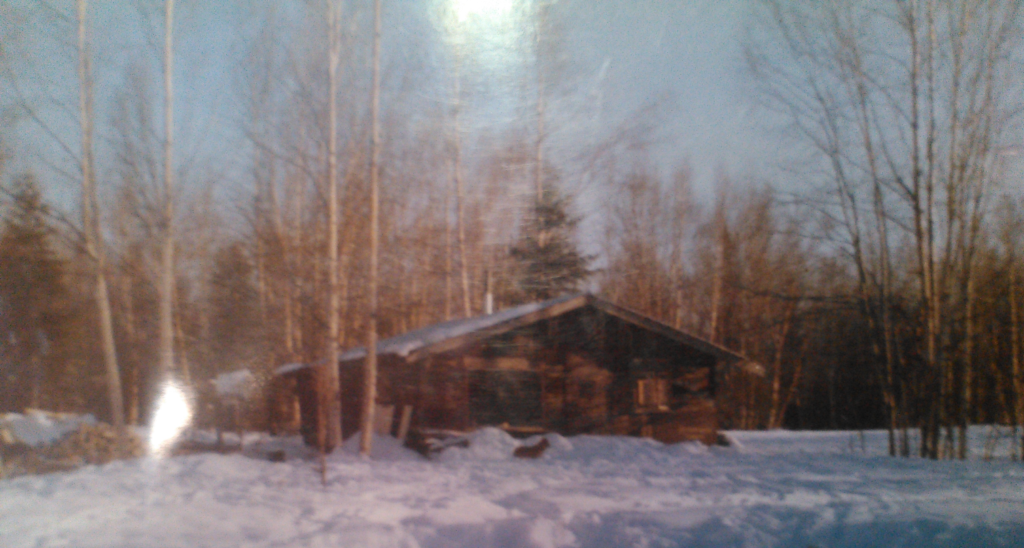
Lydic homestead 1960 from the Lydic Collection
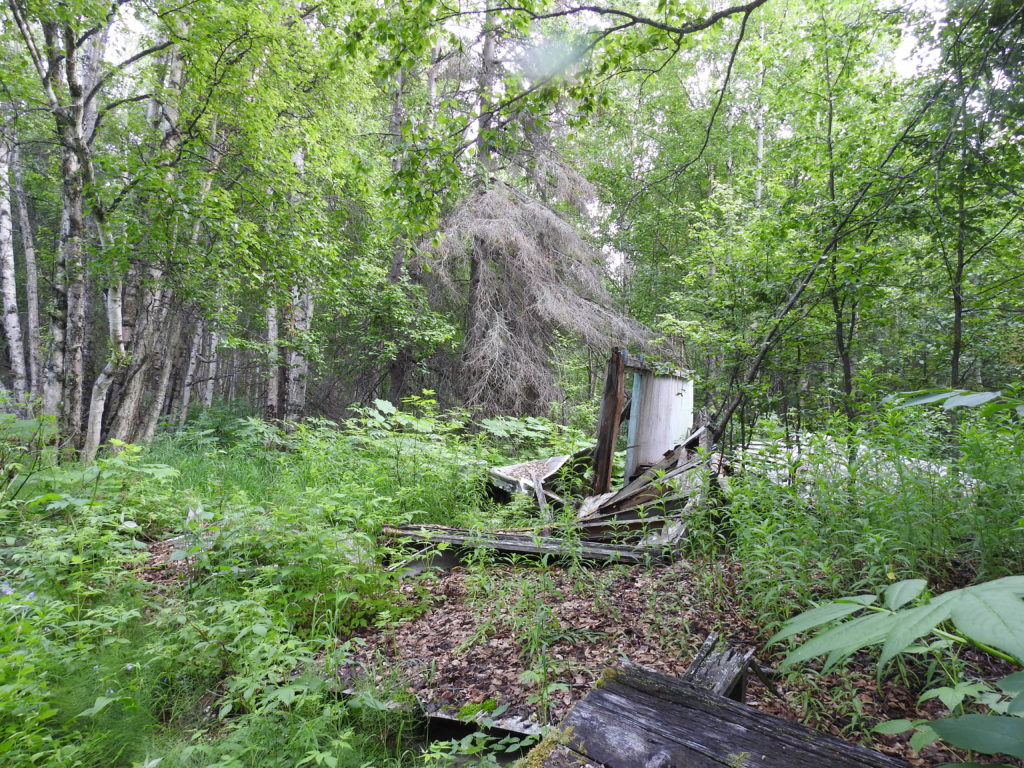
Lydic homestead from my collection2017
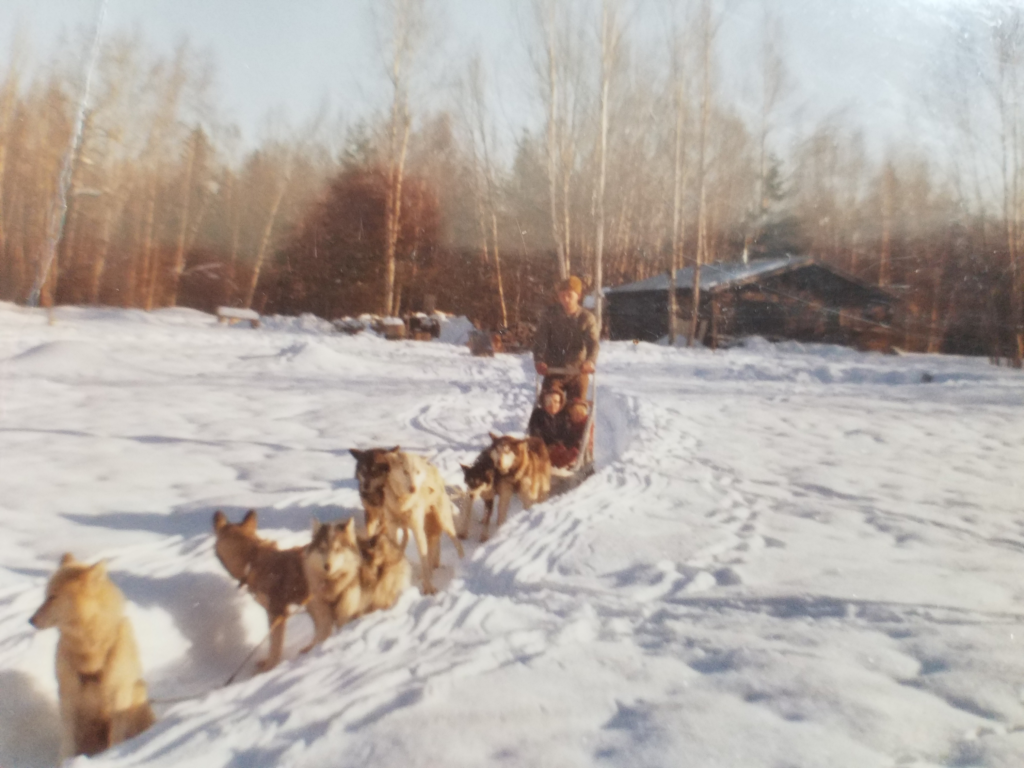
Bill & the kids on the dogsled in front of the cabin Lydic Collection
-----Read the Seeholzer story next where Grace and Joe Seeholzer come to live at Susitna Station with Granny and the Lydics.


